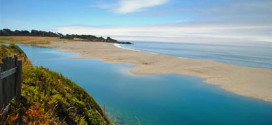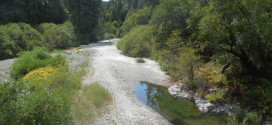Cattle from the upper watershed (Wheatfield Fork) annually move down from the dry hillslopes in August and September to graze and loaf in the cool, moist riparian zone of the Gualala River. This year, their hoofprints and manure could be found around Valley Crossing. One of the many small herds of cattle (shown below) was found on the Wheatfield Fork downstream of a gravel mining site.

Cattle indiscriminately graze riparian vegetation in the stream bed (torrent sedge, a wetland plant), on the banks (young willow), and shoreline grasses and weeds of the sand and gravel bars. They trample the bed, and deposit manure and urine (sources of toxic ammonia and urea) in summer channel pools that support fish and frogs.
There is a consensus among state resource agency scientists (NCWAP – Gualala, the North Coast Watershed Assessment Project for the Gualala River, 2002) that cattle trampling and grazing can significantly inhibit recovery of woody stream-side (riparian) vegetation. The deficiency of riparian vegetation, especially in tributaries and mainstem channels of the upper watershed, is one of the principal limiting factors for the recovery of steelhead trout.
Cattle impacts on the river are cumulative with low flows: small channel pools are disproportionately affected by cattle trampling and pollution.
No state or county agencies appear to prevent or correct this conspicuous annual cattle march on the river.
 Friends of Gualala River Protecting the Gualala River watershed and the species living within it
Friends of Gualala River Protecting the Gualala River watershed and the species living within it


